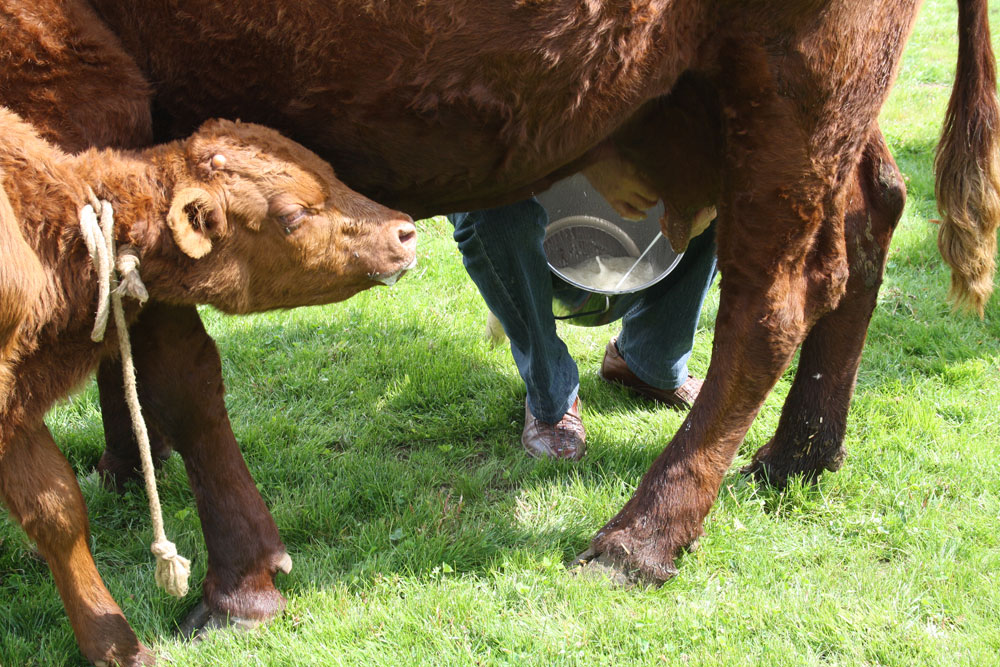
La première domestication des vaches date de 8000 avant J-C au Moyen Orient, et en Inde. Les premiers produits issus de l’élevage sont la traction et le lait transformé en fromage.
- La Simmental française : race mixte à la robe variant du rouge pâle au roux. Elle participe à l'élaboration des fromages AOC : Comté, Mont d'or, Morbier et Bleu de Gex en Franche-Comté, et laguiole dans le Massif central.
- La Salers : remarquable par sa robe de couleur rouge. Son lait était utilisé pour la production des fromages AOC régionaux, notamment le Cantal et le Salers mais il n'y a pratiquement plus de producteurs qui l'utilisent car elle est peu productive. Il reste moins de dix producteurs qui l'utilise pour la fabrication de fromage. Grimpeuse infatigable, elle n'est pas sujette au vertige, ce qui lui permet de pâturer les solitudes pentues des Monts du Cantal. En production laitière, elle peut produire jusqu'à2 000 a 2 400 kg d'un lait riche en matière grasse par lactation. La particularité de cette race est de n'accepter d'être traite qu'en présence de son veau. La salers est aujourd'hui surtout exploitée en système allaitant pour la production de veau de boucherie, souvent en croisement avec des taureaux charolais. Ils donnent des broutards lourds sans complément alimentaire. Elle est recherchée pour ses qualités de rusticité : elle supporte de fortes variations de température et un fourrage parfois grossier. Ses éleveurs louent sa fertilité et sa facilité d'élevage. Dans le Cantal, les éleveurs pratiquaient l'estive : les troupeaux passaient l'été sur les hauteurs, les estives. Les veaux grandissaient au lait de leur mère, et la traite commençait sur les pâturages riches à la fin du printemps. Ce système permettait la production de broutards de qualité et de fromage exclusivement issu du lait le plus parfumé.
- La Vosgienne : à la robe mouchetée noire et blanche. Ce lait est à la base du fromage Munster. C'est une race classée mixte, donnant un lait de grande qualité et en quantité honorable (environ 4 400 kg par an). C'est une race d'une rusticité remarquable : excellente marcheuse, peu sensible aux changements de température, elle s'accommode des reliefs difficiles et des fourrages grossiers; elle est parfaitement adaptée à la montagne. Elle a une bonne fertilité en terrain carencé. elle se laisse approcher trés facilement avec une trés légére crainte.
- L'Abondance. C’est une race mixte: bonne laitière et une bonne conformation pour la boucherie. La production de lait se situe à 5 700 kg par lactation sur 302 jours pour les plus performantes, 5 144 en moyenne en 2006 (+ 886 kg en vingt ans). Il est riche en matière grasse et en protéines avec un bon équilibre entre les deux. Le taux butyreux se situe en moyenne à entre 37,0 et 37,4 et le taux protéique entre 32,9 et 33,1. Le rapport taux butyrique/taux protéique est de 1,13, idéal pour le rendement fromager. Ce lait est à la base de la fabrication de fromages AOC, le Reblochon, l’Abondance, la tome des Bauges et le Beaufort. Ces vaches sont appréciées pour leurs qualités d’élevage : rusticité, aptitude à la marche, résistance aux amplitudes thermiques, facilité de vêlage, aptitude à la consommation de fourrages grossiers et leur longévité. Avec la difficulté de vendre leur fromage, des éleveurs savoyards la croisent avec des taureaux de race bouchère. Elle élève bien son veau en étable, puis la traite commence l'été pour produire le fromage d'alpage, le plus renommé et le plus cher. Ainsi, elle produit sur plusieurs tableaux.
- La Tarine ou Tarentaise. Elle est classée laitière. Cette race est bonne en production laitière et elle donne un lait riche en matières grasses sur des alpages où aucune race "productive" ne pourrait vivre en plein air. Elle donne 4800 kg sur 292 de lactation par an. Son lait est utilisé pour la fabrication de fromages AOC : le Beaufort, la tome des Bauges, le reblochon ou l'abondance et de fromages IGP comme l'emmental de Savoie ou la tomme de Savoie. En aptitude bouchère, elle donne un excellent rendement grâce à la finesse de ses os: 65 à 72 %. C'est une race très rustique, de bonne longévité et bien adaptée au pâturage en montagne et à la transhumance, bonne marcheuse et résistante à la chaleur comme au froid. Elle valorise bien des fourrages médiocres et elle est résistante aux maladies.